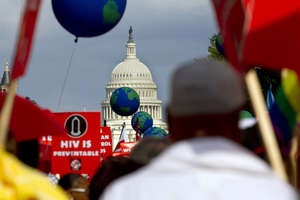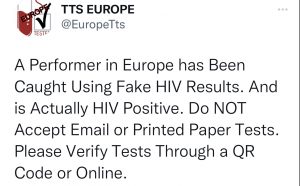WASHINGTON — From dark days to a critical turning point in the AIDS epidemic: The landscape has changed dramatically in the two decades since the world’s largest AIDS conference last met in the United States.

Back in 1990, the first good medicines were still a few years away. Before they arrived, caring for patients with HIV was like “putting Band-Aids on hemorrhages,” said the leading U.S. AIDS researcher, Dr. Anthony Fauci.
Fast forward: Today’s anti-AIDS drugs work so well they not only give people with HIV a near-normal life expectancy, they offer a double whammy — making those patients less likely to infect other people.
Sunday, the International AIDS Conference opened in the nation’s capital with the goal of “turning the tide” on HIV. Even without a vaccine or a cure, the goal is to finally stem spread of the virus, using that so-called “treatment as prevention” and some other powerful protections.
“There is no excuse, scientifically, to say we cannot do it,” Fauci, infectious disease chief at the National Institutes of Health, told reporters Sunday.
But the challenge that more than 20,000 scientists, doctors, people living with HIV and policy-makers will grapple with this week is how to get to what the Obama administration calls an AIDS-free generation. Where’s the money? What works best in different countries and cultures?
And with HIV increasingly an epidemic of the poor and the marginalized, will countries find the will to invest in the most vulnerable?
“Rich countries think, ‘Who cares? We have the treatment, I hear now that HIV is a chronic condition,'” a worried French Nobel laureate Francoise Barre-Sinoussi, co-discoverer of HIV, told The Associated Press. “I really think there is not the same political commitment as it was in the past.”
That political commitment must expand to fight laws that are driving some of the populations most at risk — gay and bisexual men, sex workers and injecting drug users — away from programs that could help protect them from getting or spreading HIV, said Michel Sidibe, director of UNAIDS, the United Nations AIDS program.(Geez, they forgot porn..)
“It’s outrageous that in 2012, when we have everything to beat this epidemic, that we still have to fight prejudice, stigma, exclusion,” he said.
People living with HIV marched through downtown Washington Sunday to urge the public and policy-makers to pay attention to a disease that, in this country, doesn’t get much publicity anymore.
“We’re everyday people. Anybody and everybody can catch this,” said Ann Dixon, who traveled from Arkansas to attend the march. She learned she had HIV in 1997.
The AIDS conference — remarkable for giving a forum not just to leading scientists but to everyday people who live with HIV — hasn’t returned to the U.S. since 1990, in protest of the longtime ban on people with the virus entering the country. The Obama administration lifted the travel ban in 2010, finishing a process begun under the Bush administration. Not lifted was a ban on sex workers and injecting drug users, and protesters briefly interrupted the opening news conference to decry their absence from the meeting.
The conference comes at a time when scientists increasingly say they have powerful new tools to add to tried-and-true condoms.
Studies show treatment-as-prevention, treating HIV right away rather than after someone is sick, lowers patients’ chances of spreading the virus through sex by a stunning 96 percent. Already, Fauci said regions that are pushing to get more people tested and rushed into treatment are starting to see infections drop, from San Francisco and Washington to part of South Africa.
The U.S. Food and Drug Administration just approved use of a daily AIDS medicine, Truvada, for use by healthy people hoping to lower the risk of infection by a sexual partner. Hard-hit poor countries are grappling with how to get that protection to their highest-risk populations.
Other goals include getting more HIV-infected pregnant women treated to protect their babies, and getting more men circumcised in developing countries to protect them from heterosexual infection.
But the hurdles are huge.
Since the first reports of AIDS surfaced 31 years ago, a staggering 30 million people have died from the virus and 34.2 million now are living with HIV around the world.
There’s still no cure and no vaccine. For every person who starts treatment, two more are becoming infected.
In poor countries, a record 8 million people are getting HIV drugs, but the United Nations says it will take up to $24 billion a year — $7 billion more than is being spent now — to reach those most in need.
The epidemic is worst in developing countries, especially in Africa. Progress has stalled even in the U.S., which has seen about 50,000 new infections every year for a decade. Here, nearly 1.2 million people live with HIV, and one in five don’t know it.
Source





